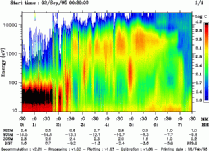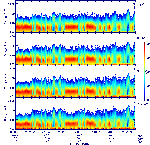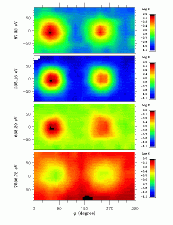(Click on the picture to view large one)
 |
Fig.1
2. Status of the ELECTRON experiment
The INTERBALL-Tail satellite is encountering plasmas of vastly diverse characteristics in the course of a year. The objective of the ELECTRON experiment is to perform 3-D measurements of the plasma electrons in the energy range from 10 eV to 26000 eV, with good angular resolution, sensitivity and large dynamical range.
The ELECTRON instrument was designed, built and calibrated by the Centre d'Etudes Spatiales des Rayonnements (CNRS/ University of Toulouse, France) and financed by a CNES (French National Space Center) grant. The integration tests were performed jointly with the Space Research Institute, Moscow (IKI).
Experiment scientific team:
J.A. Sauvaud, T. Beutier, J.M. Bosqued, J. Crasnier, J. Dandouras, C. Jacquey, H. Reme
Centre d'Etude Spatiale des Rayonnements, CNRS/U. Paul Sabatier, Toulouse, France
N. Borodkova, O. Vaisberg
Space Research Institute, Russian Academy of Sciences, Moscow, Russia
The spectrometer consists of a quadri-spherical analyzer associated with microchannel plates. The analyser is a symmetrical "top hat" electrostatic analyzer which provides a 180° x 6° field of view with a uniform response. The angular resolution is 22.5° x 6°. Electrons are multiplied by a chevron-mounted pair of MCP associated with 8 anode sectors. Due to the spacecraft rotation, the full 4 solid angle is scanned once per spin period (~120 seconds). The number of energy sweeps per spin can be changed, as well as the energy range, according to the mode of operation. Figure 1 presents the ELECTRON sensor. Left part shows the inner hemisphere coated with copper sulfide and the MCP ring. Central part is the collimator. Right part, the complete detector with an attenuation grid at the collimator entrance.
 |
The data processing system, based on a 16 bit microprocessor controls the operation of the analyzer, formats the data for the TM channel and receives and execute commands. The spectrometer can be operated in 15 main modes. Standart modes allow to obtain 32 energy spectra with 32 energies per spin, high speed modes can be used to quickly sweep 4 energies.
The ELECTRON experiment operates from August 14, 1995. The detector has a very low background and a good sensitivity. Data have been regularly obtained in the different regions of circumterrestial space, such as solar wind, magnetosheath, magnetospheric lobe, plasma sheet, auroral regions, cusp and inner magnetosphere. Experiment don't operate in the radiation belts. The satellite apogee was located at midnight on November 1995.
 |
 |
 |
 Back to the Interball Home Page
Back to the Interball Home Page